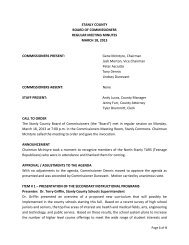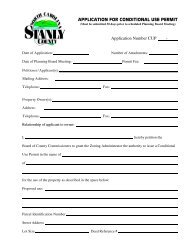Land Use Plan – 2002 - Stanly County, North Carolina
Land Use Plan – 2002 - Stanly County, North Carolina
Land Use Plan – 2002 - Stanly County, North Carolina
Create successful ePaper yourself
Turn your PDF publications into a flip-book with our unique Google optimized e-Paper software.
STANLY COUNTY<br />
The <strong>Land</strong> <strong>Use</strong> <strong>Plan</strong> is designed to guide future development so that <strong>Stanly</strong> <strong>County</strong>’s character is<br />
not lost to the gradual and insidious effects of rural sprawl. The plan attempts to lay out a<br />
program to preserve the county’s natural attributes, quality of life, and productive agricultural<br />
land. The <strong>Land</strong> <strong>Use</strong> <strong>Plan</strong> attempts, through a series of general principles and specific<br />
recommendations, to promote and retain <strong>Stanly</strong> <strong>County</strong>’s assets through the logical location of<br />
intensive land uses, the recognition of agriculture as an essential element of the overall<br />
community, and the conservation of open spaces and sensitive lands.<br />
The <strong>Land</strong> <strong>Use</strong> <strong>Plan</strong> also recommends a close association between land use decision-making<br />
and public infrastructure investment. While the <strong>Land</strong> <strong>Use</strong> <strong>Plan</strong> does not make specific<br />
recommendations for future roadway improvements, specific recommendations for utility capital<br />
improvements, or specific recommendations for community facility investment, it does seek to<br />
coordinate these endeavors within an overall program guided by the <strong>Land</strong> <strong>Use</strong> <strong>Plan</strong>.<br />
Table 6-1 provides a summary of the nine land use principles guiding the land use plan<br />
recommendations. Each principle is described in detail below:<br />
Table 6-1. <strong>Stanly</strong> <strong>County</strong> <strong>Land</strong> <strong>Use</strong> <strong>Plan</strong> Principles.<br />
Number Principle<br />
1 Future growth and development in <strong>Stanly</strong> <strong>County</strong> should be directed to the<br />
county’s existing cities, towns, and other, established population centers.<br />
2 Protect farming as an essential element of <strong>Stanly</strong> <strong>County</strong>’s future in terms of<br />
culture, economy, and land use.<br />
3 Focus development to areas of the county where the physical conditions of the<br />
land can naturally support and are appropriate for non-agricultural land uses.<br />
4 Protect <strong>Stanly</strong> <strong>County</strong>’s unique natural and cultural resources<br />
5 <strong>Use</strong> long-range planning for public infrastructure investments—public utilities,<br />
road infrastructure, and emergency/safety service—as an opportunity for<br />
community building in the county.<br />
6 Encourage land use patterns that provide a compact mix of land uses at a higher<br />
intensity of development.<br />
7 The provision of parks, recreation, and open space needs to be an element of<br />
future land use planning in <strong>Stanly</strong> <strong>County</strong>.<br />
8 <strong>Use</strong> the <strong>Land</strong> <strong>Use</strong> <strong>Plan</strong> recommendations to promote the economic development<br />
of <strong>Stanly</strong> <strong>County</strong> through a balance of traditional economic development practices,<br />
and the recommendations of the <strong>North</strong> <strong>Carolina</strong> Central Park concept.<br />
9 Cooperation between the county, communities, and other entities offers the best<br />
solution to future land use planning in <strong>Stanly</strong> <strong>County</strong>.<br />
Source: Woolpert LLP, <strong>2002</strong>.<br />
1. Future growth and development in <strong>Stanly</strong> <strong>County</strong> should be directed to the<br />
county’s existing cities, towns, and to other established population centers.<br />
Historically <strong>Stanly</strong> <strong>County</strong>’s development pattern focused on the small cities and towns located<br />
in every corner of the county. Regardless of the emergence of the industrial economy through<br />
the “cotton mills in the cotton fields” initiative a century ago, or the arrival of the railroad, or the<br />
improvement of roadways linking <strong>Stanly</strong> <strong>County</strong> to outlying markets, the majority of the<br />
population living in the county lived what are today’s nine incorporated municipalities: Albemarle,<br />
Badin, Locust, New London, Norwood, Oakboro, Red Cross, Richfield, and Stanfield. Other,<br />
much smaller population centers include unincorporated towns and crossroad settlements such<br />
as Aquadale, Endy, Millingport, and Misenheimer.<br />
A central recommendation of the <strong>Stanly</strong> <strong>County</strong> <strong>Land</strong> <strong>Use</strong> <strong>Plan</strong> is to encourage development in<br />
the eight cities first, then to areas adjacent to them. Where utilities and good roadway access is<br />
available, development should be focused toward the larger towns—Aquadale, Endy, Finger,<br />
Frog Pond, Millingport, Misenheimer, Plyler, and St. Martin—as well. This recommendation is<br />
based on the reasoning that all these communities are the portions of the county that are most<br />
<strong>Land</strong> <strong>Use</strong> <strong>Plan</strong> 6-3 6/02






